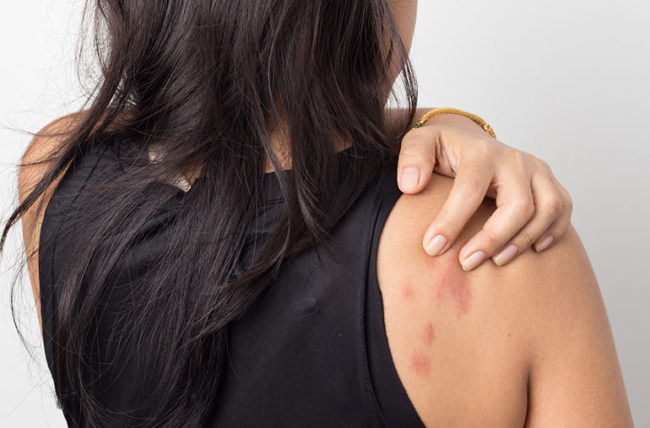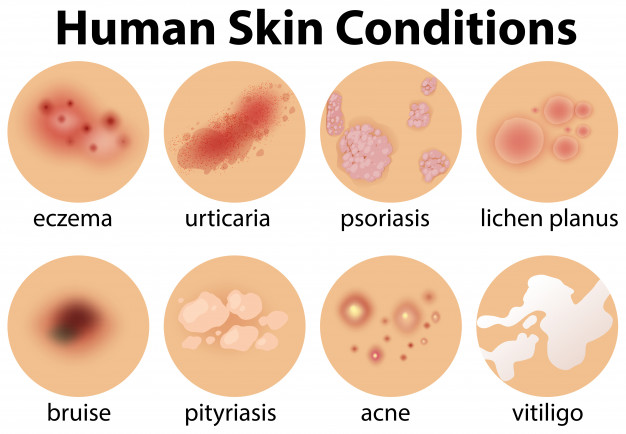Do you feel that your skin is becoming a tad bit too itchy? No, it might not be the summer heat.

The redness and itchiness caused on your skin mostly triggered by allergens are hives.[1] These are usually allergic reactions that can have an impact on your overall health. Hives are also known by different names such as urticaria, nettle rash, or welts.
If the allergens attack your body, histamine, a protein will be released in the body. Once the histamine is released, the capillaries will lead to leaking fluids. The accumulation of these leaking fluids on the skin leads to skin rash.[2]
Most people consider hives to be life-threatening, but they are not. Hives affect around 20% of people around the world. However, these are indeed annoying because of the increased itchy feeling. One good thing about hives is that it is not contagious.
Facts about Hives
It is necessary to know a few facts about it before jumping to the causes and symptoms of hives.[3]
- Hives change size from time to time and disappear from one part only to appear in the order after a certain time.
- Hives can reoccur if it is not treated.
- Environmental factors such as cold, sunlight, and heat can also be the rising causes of hives.
- Hives treatment may need to be conducted for a long time, depending on the seriousness of the condition.
- Antihistamines can help to avoid the increased risk of hives.
What are the causes of hives?
Hives may occur in your body only if it comes in contact with an allergen. Once the histamine is released in the skin, a hive breakout may appear on the skin surface.[4]
The combination of histamines and other chemicals leads to an increase in rash due to inflammation.
Some of the prominent causes of hives include
- Latex
- Pollen
- Insect bites and stings
- Sunlight exposure
- Chemical
- Dander
- High body temperature
- Bacterial infection
Antibiotics and non-steroidal medicines
Most people are often unaware of the exact cause of hives.[5] Sometimes it also starts as an autoimmune response, but the specific reason for it happening is still unclear.
Kinds of hives
Hives are usually identified into three categories[6]
- Acute Hives- These generally disappear within six to eight weeks, depending on the treatment.
- Chronic idiopathic urticaria- These, despite treatment, would last for more than six to eight weeks.
- Angioedema- These are very much like hives but affect only the deeper layers of skin.
Acute hives are widespread and happen every now and then. Since it does not have any severe side effects on health, the doctor would not recommend a time frame of more than eight weeks to treat hives.[7]
However, chronic idiopathic urticaria is very unprecedented and very rare. Studies show that only 1 out of 1000 people are prone to this condition. Different viruses can also be the major cause of hives. In some situations, the hives may also be a result of other autoimmune disorders such as lupus or thyroid.

Symptoms
Hives are often confused with being a typical rash because of their appearance. The outbreak of hives will lead to the frequent occurrence of wheals, pink or red, oval or round in shape.[8]
Hives are just a few millimeters or a few inches. In the initial period, they tend to be itchy and have red sores around them. One of the characteristic features of hives that differentiates it from the widespread rash is that the hives can occur in batches under extreme conditions. The occurrence of hives can be seen around legs, feet, fingers, hands, and arms.[9]
The hives may disappear now, but they are likely to appear within 24 hours again. Depending on the severity of the condition, hives may occur on one part of the body or on the others as well. The fading of hives can further pave the way for the wheals to appear.[10]
While hives go away in a few weeks, some people experience symptoms for years and months.
Diagnosis
There are high possibilities that you are suffering from hives and angioedema at the same time. It would help if you visited a doctor who will carry out a verbal test (question and answer) to find out the possible cause of angioedema and hives.
There are other ways of confirming the test for swelling. The type of test conducted will mostly be dependent on your medical history. It would be best to visit a dermatologist to find the best results.
The dermatologist may further conduct a skin test to find out the particular item you are allergic to. If you are prone to such illnesses, the doctor may recommend you to carry out frequent blood tests to prevent the illness from spreading.[11]
What is the Treatment?
Experts recommend the easiest task for getting rid of hives is to eradicate the trigger. But it isn’t that easy, as suggested. The doctor will only prescribe antihistamines to prevent histamines from spreading. Once you become prone to hives, you must keep conducting the tests to avoid any risks.
Chronic histamines are hard to treat, and the combination of different medicines can offer relief to it. Under certain conditions, your body may not respond efficiently to antihistamines. Hence, your doctor may further prescribe you oral corticosteroids. This medicine will only be prescribed if you are above 12 years of age.
Severe hives or angioedema is very rare. Often, people who have it are given injections of epinephrine (adrenaline). At the same time, cortisone medicines can be of great help to treat the problem.
Keeping yourself cool is the only way to protect yourself from hives infestation. If you are suffering from hives, you need to ensure that the affected areas are moist. Frequent visits to the doctor once you spot the signs can be pretty helpful for preventing the virus.
[1] https://www.ncbi.nlm.nih.gov/pmc/articles/PMC2492902/
[2] Kaplan AP. Clinical practice. Chronic urticaria and angioedema. N Engl J Med. 2002;346:175–9. [PubMed] [Google Scholar]
[3] Hourihane JO’B. Recent advances in peanut allergy. Curr Opin Allergy Clin Immunol. 2002;2:227–31. [PubMed] [Google Scholar]
[4] https://pubmed.ncbi.nlm.nih.gov/18700329/
[5] Kanerva L, Tarvainen K. Allergic contact dermatitis and contact urticaria from cellulolytic enzymes. Am J Contact Dermat. 1990;1:244–5. [Google Scholar]
[6] https://www.ncbi.nlm.nih.gov/pmc/articles/PMC3276885/
[7] Beezhold DH, Sussman GL, Liss GM, Chang NS. Latex allergy can induce clinical reactions to specific foods. Clin Exp Allergy. 1996;26:416–22. [PubMed] [Google Scholar]
[8] Schwartz HJ. Latex: a potential hidden ‘food’ allergen in fast food restaurants. J Allergy Clin Immunol. 1995;95:139–40. [PubMed] [Google Scholar]
[9] https://pubmed.ncbi.nlm.nih.gov/17137459/
[10] https://www.ncbi.nlm.nih.gov/pmc/articles/PMC2804274/
[11] Greaves MW, Sneddon IB, Smith AK, Stanworth DK. Heat urticaria. Br J Dermatol. 1974;90:289–92. [PubMed] [Google Scholar]

